

In philately, a die is the engraved image of a stamp on metal which is subsequently multiplied by impression to create the printing plate (or printing base). [1]


In philately, a die is the engraved image of a stamp on metal which is subsequently multiplied by impression to create the printing plate (or printing base). [1]
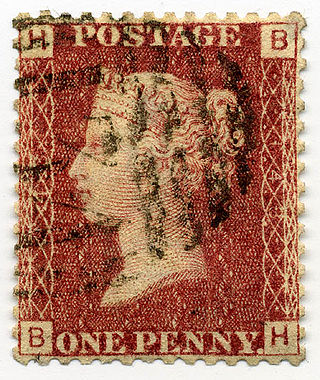
Philately is the study of postage stamps and postal history. It also refers to the collection and appreciation of stamps and other philatelic products. Philately involves more than just stamp collecting or the study of postage; it is possible to be a philatelist without owning any stamps. For instance, the stamps being studied may be very rare or reside only in museums.
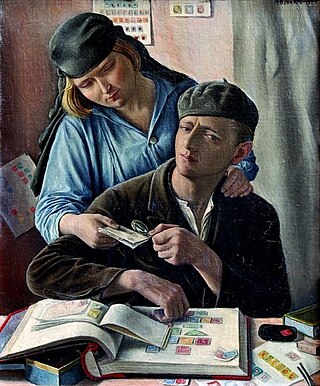
Stamp collecting is the collecting of postage stamps and related objects. It is an area of philately, which is the study of stamps. It has been one of the world's most popular hobbies since the late nineteenth century with the rapid growth of the postal service, as a never-ending stream of new stamps was produced by countries that sought to advertise their distinctiveness through their stamps.

Indian postal systems for efficient military and governmental communications had developed long before the arrival of Europeans. When the Portuguese, Dutch, French, Danish and British conquered the Marathas who had already defeated the Mughals, their postal systems existed alongside those of many somewhat independent states. The British East India Company gradually annexed the other powers on the sub-continent and brought into existence a British administrative system over most of modern-day India, with a need to establish and maintain both official and commercial mail systems.
This is a list of philatelic topics.

In philately, a cachet is a printed or stamped design or inscription, other than a cancellation or pre-printed postage, on an envelope, postcard, or postal card to commemorate a postal or philatelic event. There are both official and private cachets. They commemorate everything from the first flight on a particular route, to the Super Bowl. Cachets are also frequently made, either by private companies or a government, for first day of issue stamp events or "second-day" stamp events. They are often present on event covers.

Yvert et Tellier is a postage stamp dealer and a philatelic publishing company founded in 1895 in the northern French city of Amiens, where the head office is still located. The logo is a circle divided into a snowflake and a smiling sun. It is a pun on the name of the company: hiver, été liés sounds a lot like the French pronunciation of Yvert et Tellier.

The postage and revenue stamps of the United Kingdom issued in 1887 are known as the "Jubilee" issue because they were issued during the year of the Golden Jubilee of Queen Victoria to the throne in 1837. They continued in use throughout the remainder of Victoria's reign, and many of the designs were reused in the stamps of Edward VII. The Jubilee issue includes the first British stamps to be printed in two colours.
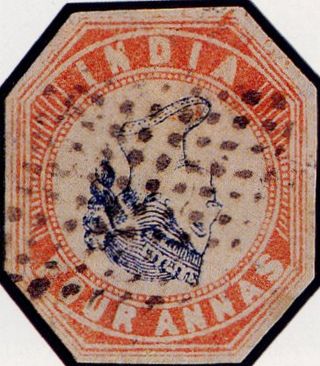
The Inverted Head Four Annas of India is a postage stamp prized by collectors. The 1854 first issues of India included a Four Annas value in red and blue. It was one of the world's first multicolored stamps; the Basel Dove preceded it by nine years. However, an invert error occurred during production, showing the head "upside down."
Théodule Tellier was a French printer and the co-founder with Louis Yvert of French philatelic publisher Yvert et Tellier. He participated in its publication from 1895 to 1913.

The Castle series or Castle High Value series are two definitive stamp series issued in the United Kingdom during Queen Elizabeth II's reign. The common aspects of the two series are the four chosen castles, one for each country of the United Kingdom.
Admirals are a series of definitive stamps issued by three countries of the British Commonwealth that show King George V of Great Britain and the British Dominions. The stamps are referred to as the Admirals because King George is depicted in his Admiral of the Fleet uniform. The stamps were issued by Canada in 1911–1928, New Zealand in 1926, and Rhodesia in 1913–24.
The United States Stamp Society (USSS) is the largest philatelic organization dedicated to the research and study of United States postage and revenue stamps. The Society is a non-profit collector-based organization with a world-wide membership of over 1700. The USSS is Affiliate #150 of the American Philatelic Society (APS). Since 1930 the Society has encouraged philatelic study through voluntary membership in specialized committees, including those for specific stamp issues like the Washington-Franklins, the Prexies or the Liberty Series, and areas of U.S. philately such as Plate Numbers, Marginal Markings, Private Vending and Affixing Perforations, Booklets and Panes, and Luminescence. Research is made available through published books, research papers and articles in the monthly journal, The United States Specialist.

Postal history in the territory that now constitutes Latvia began during the 13th century, when the Archbishopric of Riga was included to the area of postal operations of the Monastic state of the Teutonic Knights and the Hanseatic League. In 1580 the Hanseatic League issued their first known regulations on courier work and payroll, regulations that also were active in the territory that now constitutes Latvia.

Nepal has a long postal history. The modern form of postal service was started by the Rana Prime minister Ranaudip Singh in 1878. He established the first post office which was named Nepal Hulak Ghar. In 1881, the first postal stamp was issued. As of 2020, about 1367 types of postal stamps have been issued. Currently, the postal service is regulated by the Postal act of Nepal. Nepal Post, locally known as Hulak Sewa(Nepali: हुलाक सेवा विभाग) or Daak Sewa(Nepali: डाँक सेवा) under the Ministry of Information and Communications is responsible for the postal service in Nepal.
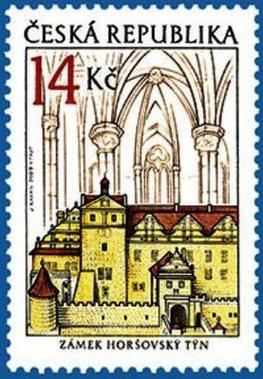
This is a survey of the postage stamps and postal history of the Czech Republic.

This is a survey of the postage stamps and postal history of Czechoslovakia.

The British Library Philatelic Collections is the national philatelic collection of the United Kingdom with over 8 million items from around the world. It was established in 1891 as part of the British Museum Library, later to become the British Library, with the collection of Thomas Tapling. In addition to bequests and continuing donations, the library received consistent deposits by the Crown Agency and has become a primary research collection for British Empire and international history. The collections contain a wide range of artefacts in addition to postage stamps, from newspaper stamps to a press used to print the first British postage stamps.
The Crown Agents Collection is a collection of unused British Commonwealth philatelic material produced by the Crown Agents since 1922. The collection forms part of the British Library Philatelic Collections. Material given by the Crown Agents from 1900 to 1922 is included in the Supplementary Collection.

The Greek god Hermes, messenger of the Gods in the Greek mythology, is the representation chosen, in 1860, by the Kingdom of Greece to illustrate its first postal stamps.
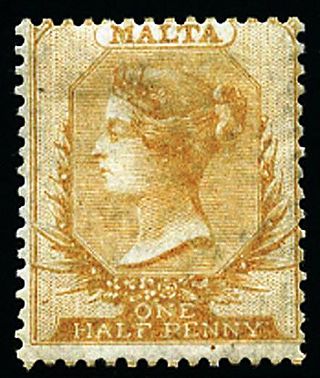
The Halfpenny Yellow is the first postage stamp issued by the Crown Colony of Malta. Depicting Queen Victoria, it was only valid for local postage and it was originally issued on 1 December 1860. It was the only stamp issued by Malta for two and a half decades, and during this period various reprints were made with differences in colour shade, perforation and watermark. When control of Malta's postal service was transferred to the island's colonial government on 1 January 1885, the stamp was withdrawn and it was replaced by a set of definitive stamps.